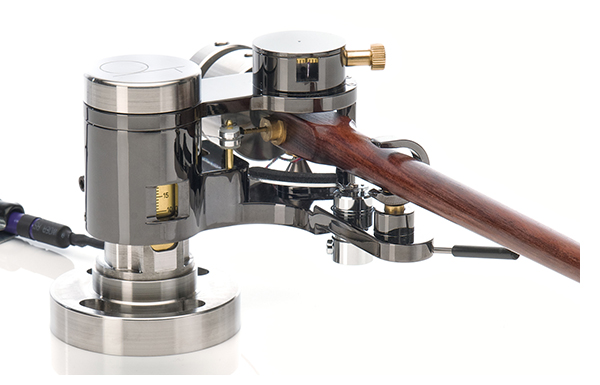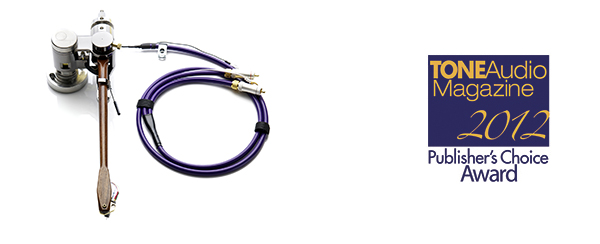REVIEW: Durand Tonearms – Talea
Listening to Frank Sinatra sing “Stormy Weather,” via the Talea Tonearm, combined with the Miyajima Kansui cartridge and AVID Volvere SP turntable, the utter clarity this combination provides is unmistakable.
Sinatras voice is crystal clear (thanks, in part to the latest MoFi remaster) yet with a beguiling dimensionality even beyond what I’m used to from the same combination, with a different tonearm.
It often feels like a wacky episode of Mythbusters, here at TONEAudio. A tonearm with a wooden armwand? That can’t work. A wood body cartridge with a wooden arm? That will sound terrible. Transistors? Forget it.
Audiophiles are usually highly opinionated. The longer many spend in the pursuit of high quality sound, the tougher their convictions are to change. I’m positive I was a wire-haired fox terrier in another life and I gravitate towards the different, the unexpected, or the thing that “shouldn’t” work. Leading me instantly to the Talea.
This $9,500 tonearm arrives in a neatly constructed wooden box, that probably doesn’t cost all that much to make, yet the amount of care spent in its design and execution foreshadows the thought spent on the tonearm’s construction. To those that complain about the containers that some gear is packaged, I appreciate the extra effort. At this price, packaging commensurate with the product goes another step forward, reinforcing value. You wouldn’t feel quite right about buying a bespoke watch in a cardboard box, would you?
The Talea is a unipivot design, and is available with a fixed tonearm cable or a breakout box, allowing the use of standard 5 pin tonearm cables. Having this option will be of more interest to the user enjoying more control over this parameter. Initial listening was done with the fixed tonearm cable, a Discovery Cable Plus 4. Due to the delicate nature of the phono signal, and after using a number of premium cables at my disposal, I suggest sticking with the permanent cable, so that the delicate phono signal travel through as few junctions as possible.
The Talea is a 10.3-inch arm, but its offset pivot point allows it to be used in the same applications that a 9-inch arm can be fitted. A quick call to AVID produced a custom mounting plate, and now that their engineers have the CAD profile stored, any AVID owners considering the Talea need only drop a note to the factory. Those using a different table can take advantage of the handy mounting template and protractor included.
Assembly and setup is straightforward, taking about 45 minutes via the skilled hands of Mr. Durand. After a few cartridge swaps, I quickly got the hang of the Talea, and thanks to VTA and azimuth on the fly, this is the easiest tonearm I’ve had the pleasure of setting up.
 Color but not colored
Color but not colored
Tonearms, like loudspeakers often take a different approach in their construction. One school of thought works in aluminum and composites, attempting to subdue every molecule of vibration and resonance from the cabinet, letting only the sound of the drivers come through. Yet another works with the driver and cabinet resonances to produce the final sound.
I’ll make no bones about it; I prefer the latter approach in speakers. The massive, metallic speakers have always left me just a little cold. Guilty as charged when it comes to analog. What’s the point of getting away from all the things that digital has to offer, strictly for an analytical sound?
After hundreds of hours listening to the Talea, it doesn’t sound colored. It’s more like tint in the color of a photographic image, or muddiness in the middle tones of color that mask fine gradations are absent with the Talea – it is truly a high definition tonearm. Think of the difference between listening to a comparison between a rare Stradivarius violin and something less exotic. Or for that matter, a 1963 Fender Stratocaster versus a Squire Stratocaster. The notes produced are the same, yet the fine tonal gradations, the decay, the feel is completely different. There is more tonal saturation everywhere.
That’s what the Talea brings to the game. Designer Joel Durand, a musician himself, discusses the myriad variations taken in developing this tonearm and how every material chosen for the arm is based strictly on its final effect on sound quality. Listening to Joe Henderson’s sax on Pete La Roca’s Basra (Music Matters 45 rpm) is a true analog delicacy. Every little quirk in Henderson’s playing is instantly delivered to the listener, while the cymbals linger that extra bit, fooling you into thinking that you are listening to the real thing.
A quick comparison
Even the mega, distorted guitar of Neil Young on his recent Americana release feels more real, more inviting. It’s easy to get caught up in the thrill of the moment when something new enters the sound chain and even easier to be fooled into thinking the new gadget is better than what we remember.
A pair of identical Ortofon Cadenza Bronze MC cartridges mounted to the Talea and the SME V arms, each on AVID Volvere SP turntables with matching Furutech AG-12 tonearm cables reveals a distinct difference between the two tonearms. While this reviewer prefers the dedicated cable, for comparison purposes, the arm wand with a breakout box allows easy cable swaps and isolates the tonearms from the reproduction chain.
Tracking further through Americana, the Talea not only delivers more texture and tonal saturation, it is the master of low-level musical nuance. The songs featuring Young’s wife, Pegi illustrate this perfectly. When using the SME, Mrs. Young is somewhat buried in the mix. Switching to the identical setup with the Talea, her voice is more easily discernible, with her voice having a more liquid quality. The growling guitars in “Travel On” feel more like you’re sitting in a club, twenty feet from the stage. Switching back to the SME, some of that air, space and magic is gone. Much like the difference between a great triode tube amplifier and a single ended triode amplifier. There’s an unmistakable richness that you will respond favorably to or not.
 Speaking of magic
Speaking of magic
The Talea has a fine-grained presentation, not at all unlike analog tape. What might be initially mistaken for a slight softness is actually an ultra fine gradation in both directions, loud and soft. This arm is the essence of natural sound; switching back and forth immediately to the SME V and TriPlanar arms (again with identical cartridges) reveals a presentation that you will either dismiss or adore. Put this reviewer in the adore category, but again remember my bias – I prefer things with a drop or two of smoothness.
On everything I could throw at the Talea, it presents a more natural timbre than everything else at my disposal, and for those fearing that a unipivot design can’t generate a solid bass foundation, you need look no further than this tonearm. The Talea, like the VPI arm (also a unipivot) doesn’t give up anything in terms of weight, just the slightest bit of ultimate slam, that I only noticed on the heaviest rock records. It is so much more intriguing everywhere else, I don’t see this as a compromise – and most of this can be mitigated by the phono cartridge you choose to pair with the Talea. The only cartridge that proved a bit soft for me in this tonearm was the Koestu Urushi Vermillion, however one staff member was highly smitten with this setup.
Listening further up the tonal scale, reveals no lack of dynamics and acceleration. Snare drums and percussion bits are as vital played through the Talea as with anything else at my disposal. The more time spent with this tonearm, the more it seduces. Its superlative ability to capture musical tones in such a natural way, just makes you forget about anything else.
While you might prefer something else for a steady diet of Led Zeppelin or Slayer, should your tastes drift more towards acoustic music, the Talea will spoil you for anything else.
Which is right?
We will probably argue over the merits of the finest examples of vacuum tube or solid-state electronics, the arguments will go on until the Earth cools. But in my system, with the cartridges at my disposal, the Durand Talea is one of the most satisfying analog experiences I’ve ever had, especially in combination with the Miyajima Kansui cartridge (review in progress) or the Clearaudio Goldfinger. This is a tonearm you should own. It is on the list of our Publishers Choice Awards for 2012.
 The Durand Talea Tonearm
The Durand Talea Tonearm
MSRP: $9,500
Peripherals
| Analog Source | AVID Volvere SP, AVID Acutus Reference SP |
| Phonostage | ARC REF Phono 2, Pass XP-25, Indigo Qualia |
| Preamplifier | ARC REF 5SE |
| Speakers | GamuT s9, Sonus faber Aida |
| Cables | Cardas Clear |
| Accessories | Furutech DeMag, DeStat, GIK acoustic treatments |



